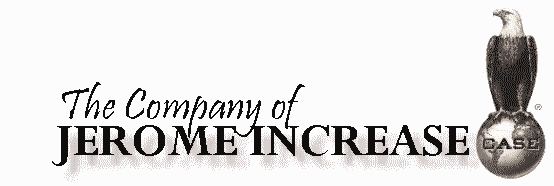

|
|
||
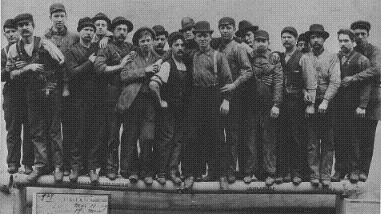

Jerome Increase Case was a young man of 23 in 1842 when he left Oswego
County, New York. His destination was Rochester, Wisconsin Territory. Case had
read that the country around Rochester was the wheat center of the mid-west, and
he planned to begin his career as a thresherman there. Eighty-nine years after he was led out to pasture for the last time, the
remains of one of the most famous racing horses in the world were exhumed in
Mount Pleasant Wednesday.
A team of historians, horsemen, an archaeologist and backhoe operator
unearthed about 80 percent of the bones of Jay-Eye-See within spitting distance
of the spots where several people said they'd be.
Soon, bones believed to belong to the famous horse belonging to Jerome
Increase Case were raining out of the backhoe bucket, much to the delight of the
20 or so elated diggers and onlookers.
"What a relief," said John Van Theil, a local historian who hopes to arrange
a more fitting burial and monument to the horse.
In the 1880s and 1890s, Jay-Eye-See notched several harness-racing records
and is still the only horse to set world records in two different gaits.
He was featured on trading cards and Currier and Ives lithographs, and was
used to sell cigars, a harness bit and, of course, farm implements.
In a day when virtually everyone used horses, Jay-Eye-See was a star that
people could easily relate to, said John Urhausen, a Racine native who raises
harness-racing horses in Elkhorn.
"He was famous worldwide," said Urhausen, who won Jay-Eye-See's enshrinement
in the Wisconsin Harness Racing Hall of Fame in January. The horse was inducted
into the Trotting Horse Museum Hall of Fame in 1990.
Wednesday morning, Urhausen and his wife, Elaine, and son were among the
eager onlookers in a field south of Highway 11, east of the former golf driving
range.
They watched as Tony Azarian of Azarian & Sons Inc. peeled off layer upon
layer of soil from the land. It is to be graded soon as part of a shopping area
including a Menard's store.
Among the onlookers was Melton Jones, 90, who remembers sitting across the
street on his parents' porch when the horse was taken out of the barn for the
last time.
The 31-year-old Jay-Eye-See was wobbling, led by one man in front and one on
each side, Jones said.
"All of a sudden he just disappeared down in the hole," Jones said. "I don't
know how they did it."
Local historian Jerry Karwowski, leaning on a shovel with the words
"Jay-Eye-See or Bust" painted on the stem, suggested the horse might be under a
slight rise to the south of the digging.
"How come they don't make a bone detector?" Azarian said with a laugh,
shouting from the cab of the Case loader/backhoe.
Joyce said he expected the burial spot would be two to three feet deep, in
mottled soil, and that most of the bones would be intact.
But could any old horse bones be mistaken for Jay-Eye-See's?
According to Karwowski, horses that died back then were sent off to
glue factories or rendering plants. That this horse was buried at all is a
tribute to its significance.
As the hot sun crossed the mid-point in the sky, enthusiasm for the dig
waned, but the devoted persisted.
Then about 2 p.m., Karwowski, a former bottle digger, came upon the
woodchuck hole with the two bones by it. Nearby was a pile of stones that seemed
to be a marker of sorts, so Azarian dug in with the backhoe.
Soon, he was bringing up bones.
"I think it's great," said Joyce, a curator with the Kenosha Public Museum.
"Frankly, I'm kind of surprised. It was like looking for a needle in a
haystack."
As diggers dug out most of the rest of the bones with hand tools, others laid
them out on a blanket.
By late afternoon, Joyce said it appeared they'd recovered 80 percent of the
bones, including large leg bones, several teeth and parts of the neck and back.
"Now we can give a proper burial that will give him more of the recognition
he deserved," Van Theil said.
He said the bones will be kept until a fitting burial site can be found,
possibly in a city park. "It depends on who takes an interest in funding the
marker," Van Theil said.
J.I. Case Plow Works ???
Jerome I. Case owned two companies bearing his name, J.I.Case Threshing machine Co. (1842) and J.I.Case Plow Works (1876). The later was organized under the name Case-Whiting Plow Company, his partner E.G. Whiting, was the inventor of the center draft walking plow. Two years later Case bought out Whiting and renamed the business J.I.Case Plow Company. The business was reorganized in 1884 and named J.I.Case Plow Works. Jerome Case withdrew from the firm in 1890 and his son Jackson I. Case became the company President. Later Henry M. Wallis Jerome Case's son-in-law became president of the firm.
The J.I.Case Plow Works was located in the factory buildings once located at the n.e. corner of Water and Marquette streets.
After his death in 1891, Jerome Case in his will disposed of all interests in the J.I. Case Threshing Machine co., and left the Plow Works to his family. This transaction later created a problem, when mail came to Racine address simply J.I.Case Racine, Wisconsin. Each piece of mail had to be opened to determine which Company it belonged too. This continued until 1928, when the J.I. Case Plow works was sold to the Massey-Harris Company. Later Massey-Harris sold all rights to the "Case" name back to the original J.I. Case Company.
In New York, young
Case purchased six "ground hog" threshers on credit and headed for Wisconsin.
Five of those machines were sold before he reached his destination, and the
sixth he kept to earn a living and use as a model for a new and better thresher
that he was to build.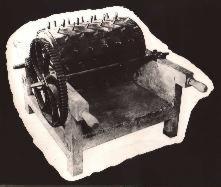
(Ground Hog
thresher)
While in Rochester, Case worked improving the crude "ground
hog" thresher. After many months of experimenting, Case developed a machine the
would beat out the kernels of wheat and separate them from the
straw.
Case planned to erect a shop in Rochester to manufacture the new
machines. However, when he approached the owners of the waterpower rights of the
Fox River dam, he was refused permission to install another millrace and wheel.
The next morning, young Case hitched a pair of horses to his threshing machine
and made his way east to Racine. 
(First Factory was located on Bridge Street. The Building was razed in 1890's to make way for the Eagle Building)
In Racine, Case rented a
small shop and began to build crude threshers, improving them as new models were
made. Each year, the business grew, and, in 1847, Case erected a three-story
brick shop in Racine that became the hub of his farm equipment manufacturing
business.
Whether he realized it or not, in building his first crude
threshers, Case had laid the foundation for the largest manufacturing concern of
its kind in the world. He had tackled the centuries-old problem of threshing
grain.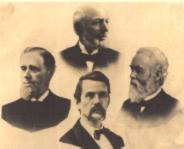
(Top
Clockwise- Jerome I.Case, Massena B. Erskine, Robert Baker and Stephen Bull. Collectively, these four men became known as "The Big Four" they managed the company until the death of Jerome I. Case in 1891)
Case operated the business by himself until 1863, when he
organized the firm of J. I. Case & Company. Forming a partnership with
Stephen Bull, Robert Baker, and Massena B. Erskine. These men became known as
"The Big Four"
Throughout the 1860s, Case had foreseen the need for a new
power source for his machines. Until this time, the machines were powered by
treadmill horsepower. Case envisioned a steam-powered thresher that would work
faster and out-perform the old horse-power method. 
(Engine Number One Built in 1869)
In
1869, the first Case steam engine was produced. It was to be followed by 36,000
more over the years. 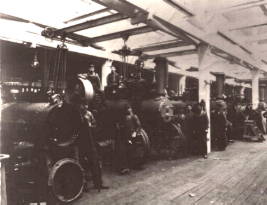
(Engine Erecting Room Main works )
This steam engine came more than 15 years before the demand
for more farm power brought on a steam- engine boom. The first Case "traction"
engine was developed by 1876. It was awarded a gold medal for excellence at the
Centennial Exposition in Philadelphia.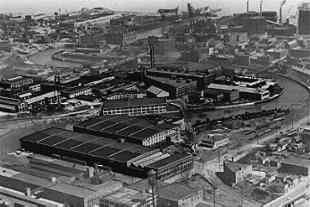
(Case Main
Works around the 1940's)
In 1880, the partnership was dissolved, and the J. I. Case
Threshing Machine Co. was incorporated. During the 1880s, Jerome Case continued
to make his presence known in his factories and to the farmers. 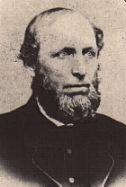
(Jerome Increase Case)
On December 22,
1891, the City of Racine was draped in mourning to honor the death of one of
America’s industrial pioneers. He was buried in Mound Cemetery in Racine.
The Case South Works
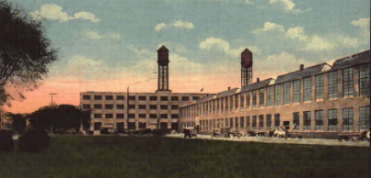
(South
Works 1913)
In the early 1900s it became evident that future Case
expansion would have to be done outside the city limits, and a large tract of
land was purchased south of Racine in the Town of Mt. Pleasant. By May of 1910,
Case Company announced plans to build a $200,000 foundry on the site. By 1913
four large buildings made up the new J. I. Case South Works. A foundry, power
plant, two story machine shop and a four story warehouse ( which had twin water
towers on its roof).
Newspaper of the time boasted the new Case South
Works as being "The Best in the World and The Plant is a City by itself." To
show off the complex J. I. Case Threshing Machine Co. hosted a "Made In Racine"
industrial exposition, held from June 9, through June 14. There 166 displays of
products manufactured in Racine.
The original foundry at the South Works,
which is still operating today remained relatively the same size until 1966,
when a large addition was added. The machine shop and assembly areas continued
to grow in size, with new additions every few years.
The "Case" Car
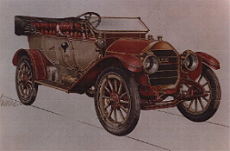
(1911 Case
Touring Car)
In 1910, the J.I. Case Threshing Machine Co. purchased the
Pierce Motor Co. of Racine, at 22th and Clark Streets. The firm had been
operating for a number of years manufacturing the Pierce-Racine automobile (no
connection with Pierce-Arrow). Case Company renamed the Automobile "Case" and
utilized the companys’ 8,000 dealers and agents world wide to sell the new
line.
Case automobiles came in Touring models, Sedans, Coupes, and a few
sporting types of a luxury class. 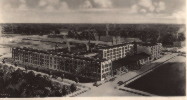
(Case Motor Car Factory-22th and Clark
St.)
The Case Motor Works displayed a strong tendency to make what
amounted to custom jobs. If a customer like the car, but objected to the color
of the upholstery, the obliging Case men would tear it out and replace it with
whatever the buyer wanted. 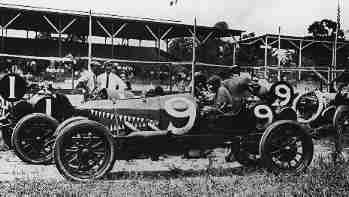
(Case Racing Team, Indianapolis 1911. Number 1 was Louis Strangs car on pole; Number 9 was "Wild Bill" Jones.)
Case , like
other car manufactures of the period , maintained a racing team. At the time it
was customary to name each individual car. A few of these cars were "Case
Bullet, White Streak, Comet, and Jay-Eye-See." Three Case Racers qualified for
the first Indianapolis 500 race in 1911, occupying the pole position and two
spots in the second row.
Case Touring cars continued to be made in modest
numbers for several years, with a price around $2,500. Case continued to build
automobiles until the mid 1920s.
Aeroplanes and Bi-planes
In the 1910s, Case also built a few
experimental airplanes and Bi- planes at the Motor Works plant. But, there is no
record of them being produced.
Old Abe

(OLD ABE)
All
companies have trademarks, and in 1865 J. I. Case Company adopted the Civil War
eagle "Old Abe" as theirs.
The story begins in 1861. Jerome I. Case
happened to be in Eau Claire, Wisconsin, when Company C of the Eight Wisconsin
was being mustered. As their mascot, the company carried an eagle named "Old
Abe" after the president. 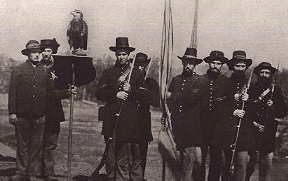
(Old Abe
with the color Guard Eighth Wisconsin Regiment)
Throughout the war, Old
Abe went through 38 battles and skirmishes and the Eighth Regiment became known
as the Eagle Regiment.
After the war, Old Abe appeared in many parades
and reviews and received the cheers of the nation.
This heroic bird
seemed appropriate as the Case Company’s symbol of excellence to the world, and
they adopted him as their trademark. 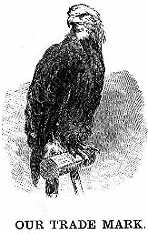
The eagle first appeared on a plain
perch.
Later, it was shown perched
on a globe of the world and became the most famous bird in agricultural history.
Old Abe reigned for 104 years as the J. I. Case Company trademark. In
1969, J. I. Case introduced a new series of agricultural tractors christened the
"Agri - King" line. At the same time, the eagle trademark was retired and
replaced by a new corporate symbol, the Casemark. This mark was used until the
acquisition of International Harvester, when IH was added to the symbol.
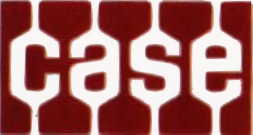
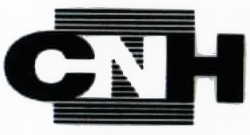

Jay - Eye - See set records in racing

During the 1870s, Jerome Increase Case became
interested in horse racing. He purchased a 200- acre farm south of the City of
Racine where Jerome Park is today and developed the Hickory Grove horse farm.
Case owned some of the finest horses in the Midwest, but the horse that became a
world champion was considered by many the joker of the Case
string.
Jay-Eye-See (named from Case’s own initials) was foaled in 1878.
He was bred by Col. Richard West of Lexington, Kentucky, and was an extra that
was thrown in for $500 with a string of horses Case had purchased to make the
purchase price of the lot fair. When the string was brought back to Racine and
tried out, Jay-Eye-See was considered to be the freak of the lot. He would rack,
pace, and trot indiscriminately. Edwin Bither, however, the farm’s trainer,
didn’t give up on him and began to mold Jay-eye-see into a winning racer. As the
horse was entered into races he continued to perform well, each time getting a
little better. 
In 1883, Jay-Eye-See was immortalized in a Currier &
Ives print, which was a great honor to hold. The same year, Case was offered
$50,000 for his horse but wouldn’t even consider the bid. Instead, Case
challenged the world for $10,000 that no horse could beat his famous
Jay-Eye-See. There is no record of any takers.
In, 1884, Jay-Eye-See
proved himself by setting a new world record of 2:10 at the Providence, Rhode
Island track.
After Jerome Case’s death, his son Jackson I. Case changed
Jay-Eye-See’s gate to that of a pacer. On the Kite track at Independence, Iowa,
in 1892, Jay-Eye-See paced a mile in 2:06 ˝ . This world record, combined with
his 2:10 trotting record, established Jay-Eye-See as the world’s all-time
champion double-gaited performer.
When Jay-Eye-See was put into
retirement, people from all over the country would stop at the Hickory Grove
farm to watch him.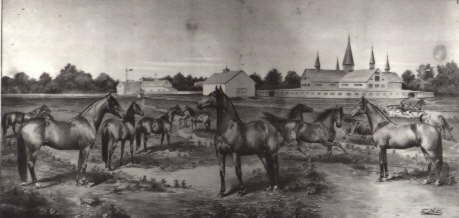
In 1909,
the little black gelding that astonished the horse -racing world died at the age
of 31. He was laid to rest, in a park-like plot, on the Charles Bull farm on
Durand Avenue, across from what today is the Case Transmission Plant.
Jay-Eye-See, however, had left his mark forever in the annals of horse
racing.
The Jay-Eye-See fame continued when the J. I. Case racing team built a high powered car named Jay-Eye-See and years later Otto Wadewitz of Racine built two powerful speed boats named Jay-Eye-See I and II.
Today there is still a street named Jay-Eye-See on Racine's southside to remind us of this amazing champion.
Racinehistory.com would like to thank the following for allowing us to
reprint the below story written by Joe Buttweiler of The Racine Journal Times,
July 3, 1997
The Racine Journal Times and RacineCounty.com are not affiliated with
racinehistory.com.
All Logos are designed and trademarked by them for them
and should not be reproduced or copied
without consent from each one
respectively
Diggers uncover remains of Case's famous race horse
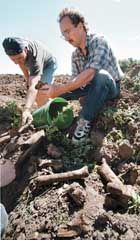 But it was a woodchuck that was given much of the credit for the
find. After several hours of fruitless digging, a couple horse bones were found
next to a small hole.
But it was a woodchuck that was given much of the credit for the
find. After several hours of fruitless digging, a couple horse bones were found
next to a small hole.
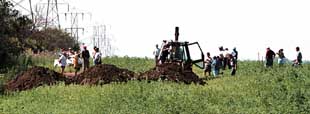 As he watched the excavation, Jones said he figured the horse was
buried slightly to the northwest of the spot where archaeologist Dan Joyce was
directing the scraping Wednesday. Jones wasn't the only one with a suggestion
about where to dig. Elaine Urhausen, who recently visited the field with Case
descendent Caleb Case, pointed to a slightly different area.
As he watched the excavation, Jones said he figured the horse was
buried slightly to the northwest of the spot where archaeologist Dan Joyce was
directing the scraping Wednesday. Jones wasn't the only one with a suggestion
about where to dig. Elaine Urhausen, who recently visited the field with Case
descendent Caleb Case, pointed to a slightly different area.
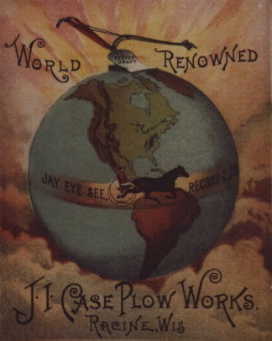
J.I.Case Plow Works advertisement, notice Jay-Eye-See running around the world.
Copyright ©
2000,2001,2002 Oak Clearing Farm & Museum
All Rights Reserved